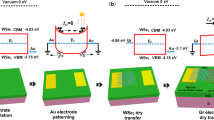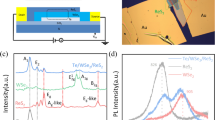Abstract
A self-driven photosensor with signal-reversal response has the potential to work as a photodetector in complex environments with multiple signals owing to better signal recognition and enhanced signal-processing efficiency. Herein, a metal-semiconductor-metal photodetector based on ambipolar WSe2 with two electrodes comprising two-dimensional (2D) van der Waals (vdWs) metal Fe3GeTe2 and semimetal graphene was proposed to form an asymmetrical metal-contacted architecture with different Schottky barrier heights. The regulating gate field-induced Fermi level shift in WSe2 can be used to manipulate the WSe2 channel’s carrier type, resulting in a polarity-reversible photodetector without a bias voltage. Furthermore, the photovoltaic effect can be observed from wavelengths of 450 nm (visible) to 850 nm (infrared) without external voltage. The large open voltage is −0.177 V and short-circuit current is 17 nA under a 650-nm excitation wavelength. The reported WSe2-based photodetector exhibits excellent properties under zero bias, including a large photo-to-dark current ratio greater than 106 with dark current less than 1 fA, photovoltaic performance with an external quantum efficiency of 27.14%, an excellent detectivity of 3.4×1010 Jones, and a high responsivity of 116.38 mA/W. Rapid electron transfer occurs at the interface between WSe2 and vdWs electrodes, resulting in a 370-µs response speed owing to the clean and nondestructive interfaces between vdWs metals and WSe2. This study demonstrates the wide application prospect of the vdWs metal Fe3GeTe2 as an electrode forming a Schottky junction for realizing a photodetector without an external voltage and accelerates the development of 2D photosensors with various working modes.
Similar content being viewed by others
References
Kyuma K, Lange E, Ohta J, et al. Artificial retinas—Fast, versatile image processors. Nature, 1994, 372: 197–198
Ngampruetikorn V, Schwab D J, Stephens G J. Energy consumption and cooperation for optimal sensing. Nat Commun, 2020, 11: 975
Mehta P, Schwab D J. Energetic costs of cellular computation. Proc Natl Acad Sci USA, 2012, 109: 17978–17982
Christesen J D, Zhang X, Pinion C W, et al. Design principles for photovoltaic devices based on Si nanowires with axial or radial p-n junctions. Nano Lett, 2012, 12: 6024–6029
Mennel L, Symonowicz J, Wachter S, et al. Ultrafast machine vision with 2D material neural network image sensors. Nature, 2020, 579: 62–66
Ma Y, Dai Y, Guo M, et al. Graphene adhesion on MoS2 monolayer: An ab initio study. Nanoscale, 2011, 3: 3883–3887
Zhang Z, Lin P, Liao Q, et al. Graphene-based mixed-dimensional van der Waals heterostructures for advanced optoelectronics. Adv Mater, 2019, 31: 1806411
Xia F, Mueller T, Lin Y M, et al. Ultrafast graphene photodetector. Nat Nanotech, 2009, 4: 839–843
Xia F, Wang H, Jia Y. Rediscovering black phosphorus as an anisotropic layered material for optoelectronics and electronics. Nat Commun, 2014, 5: 4458
Zhang K, Zhang T, Cheng G, et al. Interlayer transition and infrared photodetection in atomically thin type-II MoTe2/MoS2 van der Waals heterostructures. ACS Nano, 2016, 10: 3852–3858
Liu Y, Huang Y, Duan X. van der Waals integration before and beyond two-dimensional materials. Nature, 2019, 567: 323–333
Duong D L, Yun S J, Lee Y H. van der Waals layered materials: Opportunities and challenges. ACS Nano, 2017, 11: 11803–11830
Varghese A, Saha D, Thakar K, et al. Near-direct bandgap WSe2/ReS2 type-II pn heterojunction for enhanced ultrafast photodetection and high-performance photovoltaics. Nano Lett, 2020, 20: 1707–1717
Lee J, Duong N T, Bang S, et al. Modulation of junction modes in SnSe2/MoTe2 broken-gap van der Waals heterostructure for multifunctional devices. Nano Lett, 2020, 20: 2370–2377
Afzal A M, Dastgeer G, Iqbal M Z, et al. High-performance p-BP/n-PdSe2 near-infrared photodiodes with a fast and gate-tunable photo-response. ACS Appl Mater Interfaces, 2020, 12: 19625–19634
Wu Q, Ang Y S, Cao L, et al. Design of metal contacts for monolayer Fe3GeTe2 based devices. Appl Phys Lett, 2019, 115: 083105
Chen Y, Yin C, Wang X, et al. Multimode signal processor unit based on the ambipolar WSe2-Cr schottky junction. ACS Appl Mater Interfaces, 2019, 11: 38895–38901
Gong C, Colombo L, Wallace R M, et al. The unusual mechanism of partial fermi level pinning at metal-MoS2 interfaces. Nano Lett, 2014, 14: 1714–1720
Cui X, Lee G H, Kim Y D, et al. Multi-terminal transport measurements of MoS2 using a van der Waals heterostructure device platform. Nat Nanotech, 2015, 10: 534–540
Liu Y, Stradins P, Wei S H. van der Waals metal-semiconductor junction: Weak Fermi level pinning enables effective tuning of Schottky barrier. Sci Adv, 2016, 2: e1600069
Gweon H K, Lee S Y, Kwon H Y, et al. Exchange bias in weakly interlayer-coupled van der Waals magnet Fe3GeTe2. Nano Lett, 2021, 21: 1672–1678
Wang Z, Sapkota D, Taniguchi T, et al. Tunneling spin valves based on Fe3GeTe2/hBN/Fe3GeTe2 van der Waals heterostructures. Nano Lett, 2018, 18: 4303–4308
Deng Y, Yu Y, Song Y, et al. Gate-tunable room-temperature ferromagnetism in two-dimensional Fe3GeTe2. Nature, 2018, 563: 94–99
Wang Y, Xian C, Wang J, et al. Anisotropic anomalous Hall effect in triangular itinerant ferromagnet Fe3GeTe2. Phys Rev B, 2017, 96: 134428
Kim K, Larentis S, Fallahazad B, et al. Band alignment in WSe2-graphene heterostructures. ACS Nano, 2015, 9: 4527–4532
Ferrari A C, Basko D M. Raman spectroscopy as a versatile tool for studying the properties of graphene. Nat Nanotech, 2013, 8: 235–246
Sze S M, Li Y, Ng K K. Physics of Semiconductor Devices. Hoboken: John Wiley & Sons, 2021
Zhou C, Raju S, Li B, et al. Self-driven metal-semiconductor-metal WSe2 photodetector with asymmetric contact geometries. Adv Funct Mater, 2018, 28: 1802954
Rabbani M G, Sundararajan J P, Verma A, et al. Photoresponse of silicon with asymmetric area contacts. Semicond Sci Technol, 2017, 32: 015001
Xie C, Mak C, Tao X, et al. Photodetectors based on two-dimensional layered materials beyond graphene. Adv Funct Mater, 2017, 27: 1603886
Guo N, Xiao L, Gong F, et al. Light-driven WSe2-ZnO Junction field-effect transistors for high-performance photodetection. Adv Sci, 2020, 7: 1901637
Tersoff J. Schottky barrier heights and the continuum of gap states. Phys Rev Lett, 1984, 52: 465–468
Tan C, Wang H, Zhu X, et al. A self-powered photovoltaic photo-detector based on a lateral WSe2-WSe2 homojunction. ACS Appl Mater Interfaces, 2020, 12: 44934–44942
Du J, Liao Q, Liu B, et al. Gate-controlled polarity-reversible photodiodes with ambipolar 2D semiconductors. Adv Funct Mater, 2021, 31: 2007559
Sun M, Xie D, Sun Y, et al. Locally hydrazine doped WSe2 p-n junction toward high-performance photodetectors. Nanotechnology, 2018, 29: 015203
Wang F, Yin L, Wang Z X, et al. Configuration-dependent electrically tunable van der Waals heterostructures based on MoTe2/MoS2. Adv Funct Mater, 2016, 26: 5499–5506
Author information
Authors and Affiliations
Corresponding author
Additional information
This work was supported by the National Natural Science Foundation of China (Grant No. 51972006) and the Beijing Postdoctoral Work Funding Project (Grant No. Q6043001202101)
Supporting Information
The supporting information is available online at tech.scichina.com and link.springer.com. The supporting materials are published as submitted, without typesetting or editing. The responsibility for scientific accuracy and content remains entirely with the authors.
Supplementary material
11431_2022_2031_MOESM1_ESM.pdf
Self-powered and bipolar photodetector based on a van der Waals Metal-Semiconductor Junction: Graphene/WSe2/Fe3GeTe2 Heterojunction
Rights and permissions
About this article
Cite this article
Xu, G., Liu, D., Li, J. et al. Self-powered and bipolar photodetector based on a van der Waals metal-semiconductor junction: Graphene/WSe2/Fe3GeTe2 heterojunction. Sci. China Technol. Sci. 65, 1263–1272 (2022). https://doi.org/10.1007/s11431-022-2031-7
Received:
Accepted:
Published:
Issue Date:
DOI: https://doi.org/10.1007/s11431-022-2031-7




